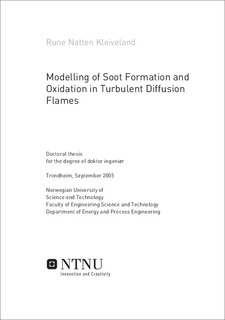| dc.contributor.author | Kleiveland, Rune Natten | nb_NO |
| dc.date.accessioned | 2014-12-19T11:25:03Z | |
| dc.date.available | 2014-12-19T11:25:03Z | |
| dc.date.created | 2006-03-17 | nb_NO |
| dc.date.issued | 2005 | nb_NO |
| dc.identifier | 125884 | nb_NO |
| dc.identifier.isbn | 82-471-7239-9 | nb_NO |
| dc.identifier.uri | http://hdl.handle.net/11250/231296 | |
| dc.description.abstract | Soot and radiation play an important role when designing practical combustion devices, and great efforts have been put into developing models which describe soot formation and oxidation. The Eddy Dissipation Concept (EDC) has proven to describe turbulent combustion well, and has the flexibility to describe chemical kinetics in a detailed manner. The aim of this work is to study how the EDC handles soot models based on a detailed representation of the gas-phase chemical kinetics.
Two versions of a semi-empirical soot model is used in conjunction with the EDC. Concentrations of various intermediate species are used as input to the soot models.
The implementation of the new soot models is discussed in relation to the previous implementation of a less detailed soot model. To assure that the interaction between soot and the gas-phase species is represented correctly, the soot models are implemented with a two-way coupling of soot and gas-phase kinetics.
Soot is a good radiator. In a sooting flame a substantial amount of energy will be transferred to the surroundings by thermal radiation. This transfer of energy will alter the temperature field of the flame and the change in temperature will affect the kinetics of soot and gas-phase chemistry. To simulate sooting flames correctly, it was therefore necessary to include a radiation model.
To validate the coupled models of turbulence, combustion, soot, and radiation two different turbulent flames were simulated. One turbulent jet flame of methane and one turbulent jet flame of ethylene. For both flames the computed results were compared with measured values.
Several aspects of the simulations are studied and discussed, such as the effect of the two-way coupling of soot and gas-phase kinetics on both soot yield and gas-phase composition, and the importance of a suitable radiation model.
The two-way coupling of soot and gas phase kinetics is shown to have a positive effect on the computed soot volume fractions, and the results are considered to be encouraging. The work has demonstrated that the EDC has the capacity to handle different types of chemical reaction mechanisms, such as mechanisms for gas-phase combustion and soot kinetics, without modification. | nb_NO |
| dc.language | eng | nb_NO |
| dc.publisher | Fakultet for ingeniørvitenskap og teknologi | nb_NO |
| dc.relation.ispartofseries | Doktoravhandlinger ved NTNU, 1503-8181; 2005:175 | nb_NO |
| dc.subject | Forbrenning, energi- og prosessteknikk, modellering og simulering | en_GB |
| dc.title | Modelling of Soot Formation and Oxidation in Turbulent Diffusion Flames | nb_NO |
| dc.type | Doctoral thesis | nb_NO |
| dc.source.pagenumber | 121 | nb_NO |
| dc.contributor.department | Norges teknisk-naturvitenskapelige universitet, Fakultet for ingeniørvitenskap og teknologi | nb_NO |
| dc.description.degree | dr.ing. | nb_NO |
| dc.description.degree | dr.ing. | en_GB |
